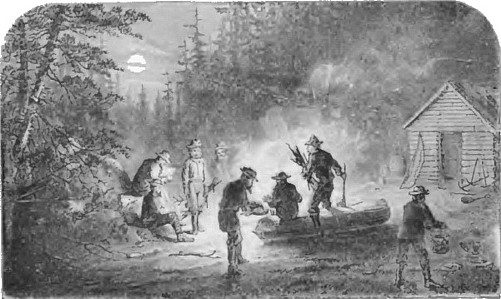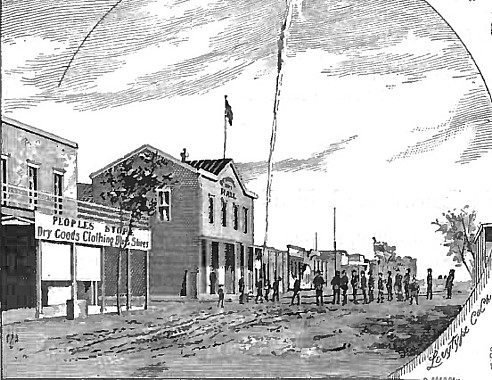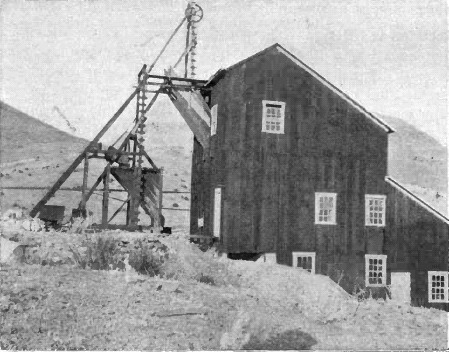MOOR, MARICOPA COUNTY
This district is situated about eight miles east of the town of
Gillette. It was first discovered in 1877, by William Moor, who, with
others, located some twenty different claims, and organized a district. The
first discoverers claimed to have found a deposit of
tin ore, but subsequent investigation proved that they were
mistaken; several
gold quartz claims, however, were found and
gold ore worked to a considerable extent by means of
arrastras, paying very handsomely. The most promising of these mines
are the Magna Charta, Gold Note and Plainwell, a group owned by Messrs.
Nilson, Carpenter, and Hutchinson, of Prescott. The deepest opening on these
claims does not exceed forty feet, but several show well-defined veins of
gold-bearing rock, from three to six feet in width, averaging thirty dollars
per ton. The district is very favorably situated, having a good wagon road
running through it, plenty of water, a first-class mill site, and
considerable wood. On the north of this district are found copper prospects,
but no developments have been made.
MYERS, MARICOPA COUNTY
This district is located in the Esperanza Mountains, in the southwestern
portion of the county. Gold ore was discovered in this section many years
ago, but the silver ledges which are being worked were discovered in 1878.
The Gunsight group, embracing several gold and silver ledges, has been
worked to a considerable extent, and a large quantity of high-grade ore
extracted. Some sent to San Francisco for reduction, is said to have yielded
from $700 to $1000 per ton. The company proposes to soon erect a forty-stamp
mill. The Silver Girt, on an adjoining lode, has yielded some rich
ore, but has not as yet been worked to any great extent. In addition to
these mines are the McLellan, and other locations, where excellent prospects
have been obtained.
OLD HAT, PIMA COUNTY
This district is situated in the northeastern part of the county, about
forty miles from Tucson. It embraces a portion of the Santa Catarina
Mountains, which are covered with forests of pine and other timber. Springs
of good water are numerous, and the climate delightful. Considerable
prospecting has lately been done, resulting in the discovery of rich ores.
The Apache Girl, one of the most prominent mines, is being vigorously
worked, and yielding high-grade ore. The extension of this mine is also
being worked with good success. The American Flag and Oracle have been
developed to a considerable extent by shafts, the former to the depth of 125
feet, showing good ore. The Kearsage and Imperial are also developing their
mines, and the latter are crushing their ore in a Huntington mill, which has
recently been erected. In addition to these are many other promising mines
which are being vigorously worked.
ORO BLANCO, PIMA COUNTY
This district is located in the extreme southern portion of the county,
being bounded on the south by Sonora. The mines in this and adjoining
districts were worked by the Mexicans many years ago. Some were remarkably
rich, and gave Arizona a reputation for mineral wealth long before the
territory came into our possession. In many places evidences of early mining
are to be seen. When the Old Ostrich mine was opened some years since, the
skeletons of the miners were found inside, and also small piles of ore ready
to be carried to the surface, indicating that the workmen had been surprised
and murdered by the Apaches. The district contains many rich ledges of gold
and
silver ore, some of which have been developed to a
considerable extent. The Warsaw mine has a large body of good ore, which
improves as depth is attained. It is developed by a shaft 125 feet deep. The
Silver Wing has a four-foot vein which presents a remarkable variety of
ores, such as sulfides of different colors,
stephanite,
cerargyrite horn silver chlorides, and gray carbonates, some of
which are very rich. The Blue Wing is being vigorously worked and yielding
good ore. The Arizona Southern Mining and Milling Co. of Philadelphia own
several locations containing high-grade ore. The San Jose Co. have recently
had some ore milled which yielded upwards of $1,000 to the ton. The Orion,
Osceola, Yellow Jacket, and Dictator are excellent mines, and are being
energetically developed. In addition to these, are many other promising
locations too numerous to mention. This section of the Territory affords
every facility for mining, wood and water being abundant and the climate
delightful.
PAJARITO, PIMA COUNTY
This district is located about 75 miles south of Tucson. The first
locations were made in 1877, and the district organized in 1880. About fifty
claims have so far been sufficiently developed to prove that they have
paying ores. The Pajarita Mining Co., incorporated under the laws of West
Virginia, J. M. McArthur, Superintendent, are taking out ore which assays
$100 per ton. The Gold Mountain Tunnel Co., C. P. Sykes Superintendent, are
also developing their claims; the formation is porphyry, ores principally
silver chlorides. Wood and water are abundant.
PALMETTO, PIMA COUNTY
This district is situated on the western slope of the Patagonia
Mountains, about twelve miles east of Calabasas. The ledges are not
generally as large as those on the eastern slope, but contain ore of a very
high grade. Wood for fuel and mining purposes is abundant, and water can be
obtained by sinking. The Tempest mine, owned by Stockton and Sutton, has a
four-foot vein, from which several tons of high-grade ore has been
extracted. The Bullion, owned by Walker & Co., has a two-foot vein giving
high assays. Some of this ore has been shipped to San Francisco, and yielded
sufficient to pay for the developments thus far made. On what is called the
Lewis ledge are several locations, promising well, which are now being
developed by shafts.
PATAGONIA, PIMA COUNTY
This district is in the southeastern part of the county, on the eastern
slope of the Patagonia Mountains. It embraces Harshaw and Washington Camp,
each with its group of surrounding mines. The district has a most salubrious
climate, and an abundance of wood and water. The Hon. P. Hamilton,
Commissioner for the Collection of Mineral Resources, gives the following
description of this rich section of the Territory: He who bestowed on this
region so uncouth an appellation as 'Patagonia,' must certainly have had a
depraved conception of the eternal fitness of things, for surely nothing
could be less suggestive of the barren plains, ice and fogs, and gigantic
savages, than this mountain paradise of Southern Arizona. Elevated about
7,000 feet above the level of the sea, its gently sloping mountains covered
with a luxuriant growth of grass and crowned with oak and cedar, with
beautiful lawn-like valleys lying between, it is the most delightful portion
of the Territory that your correspondent has yet seen. Washington Camp is
situated about nine miles almost due south from Harshaw, and less than four
miles from the Sonora line.
About three miles from Harshaw is a lovely little flat among the hills, where are the ruins of the smelting works of the Old Mowry Mine, owned and worked by Lieut. Mowry of the U. S. Army before the Civil War. A collection of adobe ruins is all that is left of what was once the liveliest mining camp in Arizona. The lofty brick chimney is still standing, a mournful monument to extinct enterprise and former active life. It is said that 400 Mexicans and their families were at one time employed at the mine and smelter. Apache warfare and civil war must answer for the destruction of this once prosperous mining enterprise. The Old Mowry Mine is now owned by parties in Tucson, and nothing is left to tell the stranger in these parts of the untiring labors and unceasing efforts of that true friend of Arizona, Sylvester Mowry, save the legend on the capping of stone near the top of the chimney, Mowry Silver Mine, 1861.'"
At La Noria are located the smelting works of the Holland Mining Co., and at the same point the W. C. Davis Co. are erecting works of a similar nature. The mines of Washington occur in limestone and porphyry, and are generally immense bodies of low-grade carbonate and galena ore. The Davis mine has a shaft 150 feet, and is thoroughly opened by crosscuts and levels, showing ore in places, twelve feet wide. About forty men are employed on the Ohio, which is producing large quantities of sulfide ore. It is owned by the Washington Pool Co., which has a dozen other claims. The Belmont is one of the oldest locations in the district, and was worked during Apache times. It has a shaft down over 100 feet, and has nearly thirty feet of low-grade lead ore. The Holland is also a large ore body. It has been under the management of Hon. J. K. Luttrell, but the attempt at smelting has not proved a success, and it is claimed that the ores need roasting and milling. Work has been stopped on this property for the present, but it is said will soon be resumed. The Silver Bill is also a fine looking property, which is now being steadily developed by Mr. Desloge for an Eastern company. There are scores of other mines in Washington Camp well worthy of mention, but space forbids. One thing can be said, the camp contains the largest bodies of ore yet found in Arizona. That it is low-grade cannot be denied, but with abundance of wood and the Santa Cruz River close at hand, they ought to be worked to a profit.
On the high hills about a mile and a half south of Harshaw, is the Hermosa mine, an immense body of free milling ore carrying chlorides and horn silver. The ore is easily reduced, and five tons to the stamp is the average work of the mill. The mine is opened by shafts, drifts and tunnels. The ore body has been cut at a depth of over 300 feet by a tunnel 700 feet in length, which pierces the mountain from side to side, thus affording plenty of ventilation. West of the Hermosa is the Hardshell, on which D. B. Gillette, formerly of Tip Top, is now operating. Although the developments are as yet but slight, the ore body is fully as large as in the Hermosa, and is said to be fully as rich. Gillette's success in the mining line is still attending him, and it is nearly certain that he has secured another bonanza fully equal to the Tip Top or the Hermosa. Nearly two miles west of the Hardshell is the Trench mine, now owned by Haggin and Tevis, of San Francisco, but worked centuries ago by the Jesuit Missionaries. Some of the finest hoisting machinery ever brought to the Territory has been erected on the property, and the mine is being opened in a thoroughly systematic manner. The main shaft is down 300 feet, and two levels have been opened. The Trench is a strong, well defined vein, with good walls, and promises to become valuable property. The Alta mine, south of the Hermosa—on which there is a shaft 100 feet—is not being worked, but it is said will soon resume operations. These are the leading mines of Harshaw Camp, and they give employment to nearly 200 men, which makes it one of the liveliest in Arizona. In the way of wood, water and delightful climate, it is not surpassed in the Territory, and its future is most encouraging. The Hermosa Mining Company's mill is one of the most complete institutions of the kind on the Coast. Everything is done on the automatic principle, and but little manual labor is required. It is turning out at present from $60,000 to $75,000 per month, and is not running to its full capacity, owing to a scarcity of water. This company commenced working ore on the 20th of August, 1880, with the following result. Value of bullion or silver bars produced from August 20th to November 30th, 1880, $275,654.49. Value of silver bars from November 30th to December 31st, estimated 190,000 ; total, $365,654.49.
Return
to The Arizona Page:
Arizona Gold Rush Mining History




